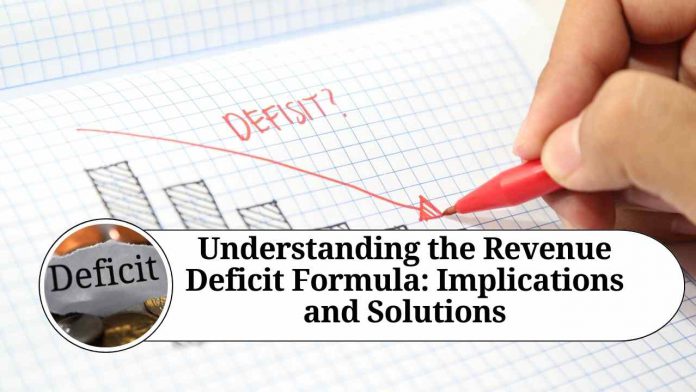The formula for calculating revenue deficit is straightforward. It is the difference between the government’s revenue receipts and revenue expenditure. Revenue receipts refer to the government’s income from taxes, duties, and other sources, while revenue expenditure includes all government spending on salaries, pensions, subsidies, and other operational expenses.
Revenue Deficit = Revenue Expenditure – Revenue Receipts
For example, let us assume that a country’s government has a revenue expenditure of $500 billion and revenue receipts of $400 billion. Using the formula, the revenue deficit can be calculated as follows:
Revenue Deficit = $500 billion – $400 billion Revenue Deficit = $100 billion
This means that the government is spending $100 billion more than it is earning, which indicates a revenue deficit.
A revenue deficit is a cause for concern because it means that the government is not generating enough revenue to cover its expenditure. This can lead to the accumulation of debt, which can have long-term economic implications. A high revenue deficit can also lead to inflation as the government may resort to printing more money to cover its expenses.
Governments can reduce revenue deficits by increasing revenue receipts or by cutting down on expenditure. Increasing revenue can be done by increasing taxes or by boosting economic growth, which in turn increases tax revenues. Cutting down on expenditure can be achieved by reducing subsidies or by implementing austerity measures.
Revenue deficits can have different types of impacts depending on the country’s economic and political situation. For example, a revenue deficit in a developing country can lead to a reduction in public services, such as education and healthcare, which can adversely affect the population’s well-being. In contrast, a revenue deficit in a developed country may lead to a decline in investor confidence and a reduction in foreign investment.
One way to reduce revenue deficits is by increasing revenue receipts. Governments can do this by increasing taxes, such as income tax, corporate tax, or value-added tax (VAT). However, this can be politically challenging as it can be unpopular with citizens who may view it as an additional financial burden. Therefore, governments need to be strategic in their tax policies to avoid creating a backlash.
Another way to increase revenue receipts is by reducing tax evasion and increasing tax compliance. Governments can do this by implementing effective tax collection systems and cracking down on tax evaders. This can be a long-term solution that provides steady revenue streams to the government and helps reduce revenue deficits.
On the other hand, reducing revenue expenditure can also help reduce revenue deficits. Governments can do this by reducing subsidies or by cutting down on unnecessary expenses. However, reducing subsidies can have social and political implications, as it can impact vulnerable sections of the population. Therefore, governments need to carefully evaluate the implications of such decisions.
In addition to reducing revenue deficits, it is essential to ensure that government spending is efficient and effective. Governments need to ensure that they are using public funds judiciously, and there is minimal wastage or corruption. This can be achieved by implementing transparent systems of governance and creating mechanisms to monitor and evaluate government spending.
Conclusion
The revenue deficit formula is a useful tool for understanding a country’s fiscal health. Reducing revenue deficits requires a balanced approach that involves increasing revenue receipts, reducing revenue expenditure, and ensuring efficient and effective government spending. Policymakers need to be strategic in their decisions to ensure that they do not adversely affect the population’s well-being while also ensuring long-term fiscal sustainability.
Other Related Blogs: Section 144B Income Tax Act
Frequently Asked Questions (FAQs)
Q: What is a revenue deficit?
A: A revenue deficit occurs when a government’s revenue falls short of its expenditure. It means that the government is spending more than it is earning.
Q: How is the revenue deficit formula calculated?
A: The revenue deficit formula is calculated by subtracting the revenue receipts from the revenue expenditure. The formula is Revenue Deficit = Revenue Expenditure – Revenue Receipts.
Q: Why is the revenue deficit important?
A: The revenue deficit is an important indicator of a country’s fiscal health. It can have significant economic implications, such as inflation or the accumulation of debt, and can impact a government’s ability to provide public services.
Q: How can a government reduce revenue deficits?
A: Governments can reduce revenue deficits by increasing revenue receipts or by cutting down on expenditure. Increasing revenue can be achieved by increasing taxes or boosting economic growth, while cutting down on expenditure can be done by reducing subsidies or implementing austerity measures.
Q: What are the implications of a high revenue deficit?
A: A high revenue deficit can have significant economic implications, such as inflation, a decline in investor confidence, and a reduction in foreign investment. It can also impact a government’s ability to provide public services and lead to the accumulation of debt.
Q: What is the role of policymakers in reducing revenue deficits?
A: Policymakers play a crucial role in reducing revenue deficits by developing policies that can increase revenue receipts, reduce expenditure, and ensure efficient and effective government spending. They need to be strategic in their decisions to ensure that they do not adversely affect the population’s well-being while also ensuring long-term fiscal sustainability.




















